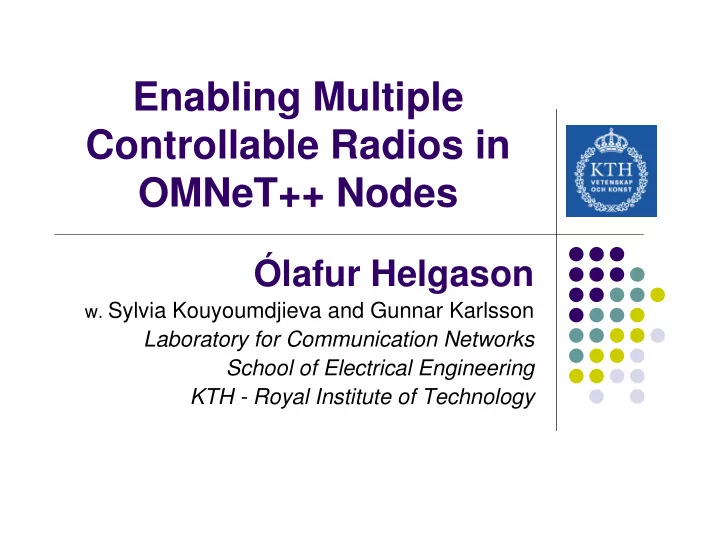

Enabling Multiple Controllable Radios in OMNeT++ Nodes Ólafur Helgason w. Sylvia Kouyoumdjieva and Gunnar Karlsson Laboratory for Communication Networks School of Electrical Engineering KTH - Royal Institute of Technology
Motivation � Wireless devices commonly have multiple radios � Cellular, WiFi, Bluetooth, Zigbee, NFC, ... � Different capabilities � Range, rate, communication mode, discovery, energy, ... � Dynamically exploiting radio hierarchies � Vertical handovers � Cognitive radio � Energy-efficiency
Energy-efficient radio subsytem � 802.11: High energy consumption even in idle mode � Dual controllable radios: � Low power, low bitrate discovery radio � High power, high bitrate data radio � HP radio suspended when idle � Goal: � Enable simulation of multi-radio nodes � Radios should be controllable � How does it affect energy consumption � We use MiXiM and the Energy Framework
Design overview: Host Secondary high-power & high-bitrate data radio Primary low-power & low bitrate control radio NICs controlled via Blackboard NICs draw energy from Battery Two (or more) independent radios per host
Controllable radios � Three states per radio � ON: Full energy consumption � SLEEP: Low energy consumption, short wakeup � OFF: No energy consumption, long wakeup � NIC is controlled via Blackboard � Facilitates flexibility in control � Application � Session layer
Implementation � NicController � Receive ctrl commands from BB � Simulate wakup delay � Turn on/off mac & phy � Publish state changes on BB
IControllable interface � Interface implemented by NIC modules � Extend existing MiXiM mac & phy classes � Does not break any existing code
Extending PHY & MAC
Conclusion � Dual radio for opportunistic networking MiXiM 802.15.4 for control radio � MiXiM 802.11 for data radio � � Evaluate content distribution performance Energy savings vs performance decrease � Effect of range disparency in control & data radios � Effect of neighbor discovery delay � See paper for prel. results on a simplified system � � Generic framework applicable to different mobile wireless services/applications � Our MiXiM fork available at https://github.com/olafur/mixim
Recommend
More recommend